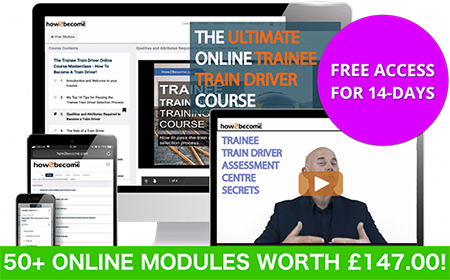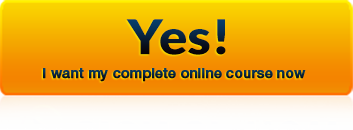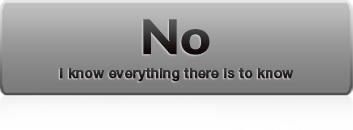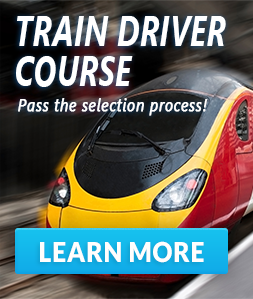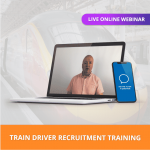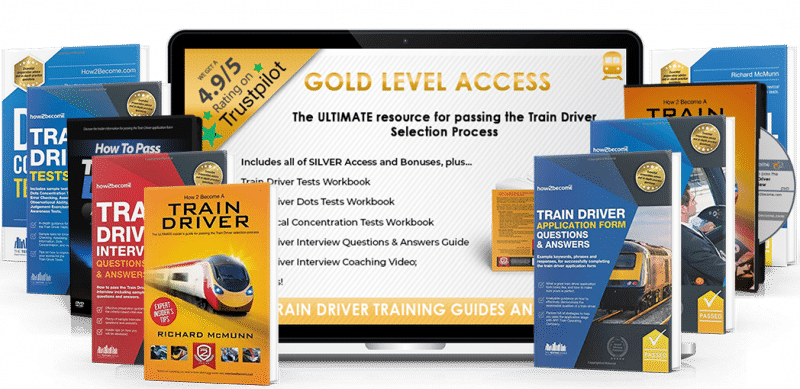Before you begin to train to become a train driver, I suggest you download and save the following:
This Railway Group Standard are issued by the RSSB and mandate training and safety requirements for train drivers and the managers. Annoyingly, these documents are regularly moved so that the above links will not work. When this happens click here and search for the document you want using the numbers given in brackets above).
You will probably also want to download copies of the various parts of the Network Rail Rule Book (You need broadband for this).
Train Driver Training
If you pass all the tests, the interviews, the medical and you get the job (and remember that whatever you hear on the grapevine you haven’t actually got the job until you’ve got the letter in your hand!), there around seven to nine months of training and examinations ahead of you, plus route learning, before you get to drive trains on your own.
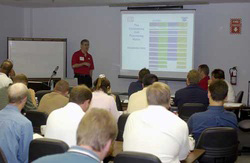
BR was always deeply reluctant to spend money on training facilities and their schools were often housed in decrepit old buildings. No one who went there can fail to remember such appalling places as Crewe or Waterloo South Side, with rain coming through the roof and chalk-dust on every surface. One of the benefits of privatisation is that many TOCs have opened shiny new training academies with proper facilities, audio-visual training aids and usually a canteen. You can expect to be in a small class of about twelve trainees. You should approach your training in a sober and professional manner. Train companies cut long serving staff a lot of slack but not newbies. They are pretty strict in the way they conduct their Driver Training Courses and you will be expected to turn up in good time each day, be well dressed, have all the materiel you need and get back from lunch punctually. You will generally not be allowed leave whilst training – so any holidays you may have booked before landing your new job will fall by the wayside. You did take out holiday cancellation insurance, didn’t you?
Train driving consists of four main components:
1 Knowledge of Rules & Regulations
2 Knowledge of Traction
3 Train Handling
4 Route Knowledge
The system of training naturally reflects this. Rules, traction and train handling are the three main parts of the course proper. The fourth, route learning, will certainly be touched on during training (especially if you happen to do your Handling Training over routes you will be working as a driver) but most of which only takes place after you have passed out. The training today is mostly based on the Driver 2000 course which replaced the old MP12 and revolves around the Network Rail Rule Book. There are moves afoot to introduce a National Standard drivers’ course along the lines of the S/NVQ which will result in the award of a Train Driver’s Certificate of Competence. (Oddly, train drivers do not have licences as such, their qualifications are just kept on file by their employers. However the EU has plans to introduce a licence, if it ever happens).
Training Schedule….
The exact training arrangements will vary from one company to another but will look something like this, spread over several months:
Will cover TOC information and policy and give you an overview of the Driver Training Course. You will also be issued with all the publications and training materiel and personal equipment you will need.
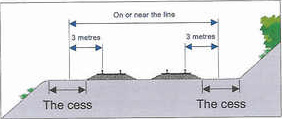
This is followed by Personal Track Safety (PTS) training based on Section G2 (Personal Safety) of the Rule Book:
Here you learn the essentials of managing your safety when working on or near the line. One of the first things is to learn are the names of the various parts of the railway – lineside, cess, four-foot, six-foot, ten-foot, refuge etc. Then you need to learn how to use high-visibility clothing, what lineside signs mean, what constitutes a position of safety, know how to ascertain the line speed, from which direction trains can approach on each track and how to contact the Signaller. You learn where you should and shouldn’t walk, which direction to face, what Limited Clearance signs mean, how often to check for approaching trains and what to do when they appear. Even though train drivers don’t get directly involved with how engineering staff set up safe systems of working during engineering work you will still need to learn about Green Zones and Red Zones, Controllers of Site Safety (COSS), Site Wardens and Lookouts. There will be overhead (Section AC) and third-rail electrification (Section DC) systems to learn about. You need to know what the various components are called, how to behave in an electrified environment, how to contact the Electrical Control Operator, get the current turned off and deal with emergencies involving electrification equipment.
After all this you will pass out on PTS. It is essential to do this first so that you can go out on the track. Train drivers do not have individual PTS cards as the qualification is included in the Train Driver’s Certificate of Competence. Additionally, some companies may give you training in first-aid and fire fighting.
Personal Track Safety
An Introduction to Railway Operations. You will be briefed by a Driver Manager, be instructed on cab etiquette and be given a Trainee’s Log Book. This book details your work on the course and will be maintained by your instructors and yourself. For about three days each week you will undertake cabs rides with senior drivers to familiarise you with your future working environment. There will be visits to a Power
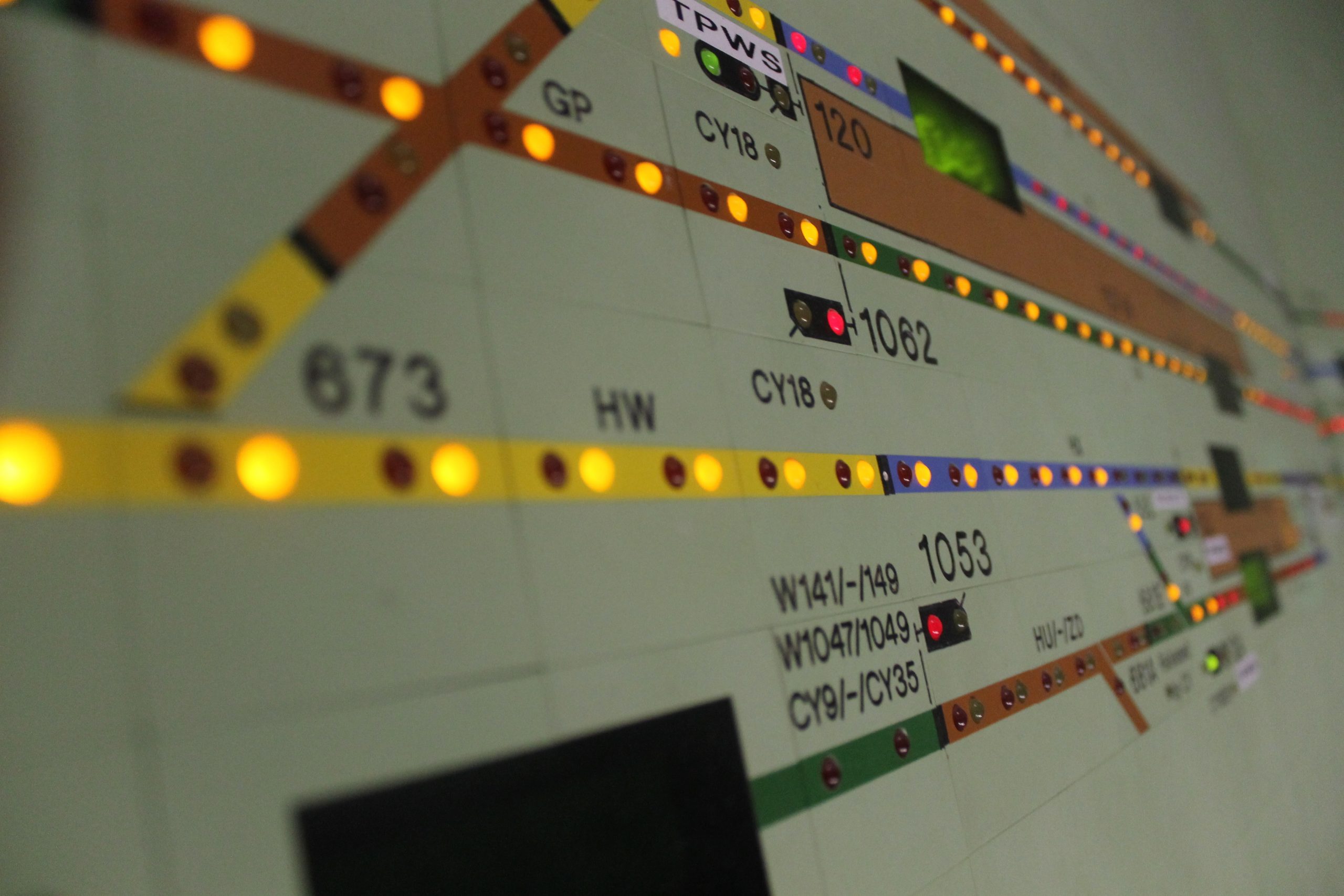
Signal Box and a Mechanical Signal Box to see how Signallers work, probably also a visit to your TOC Control Room. You will also be shown around a Train Maintenance Depot and look at the work of depot drivers.
Core Rules. This is a complex and intensive four weeks in which you need to get to grips with the Rule Book and associated publications.

Rule Book Sections to be studied (not necessarily in this order) will include:
Section G1 – General Safety Responsibility
This section deals with such as Drugs & Alcohol* policy , medical fitness, publications, clothing, going onto the lineside, walking routes, how to stop trains in an emergency, cab etiquette and cab passes, your responsibilities if there is an accident, fire or security alert. You will be taught about making clear, safety-critical communications; what it is you need to say, how to come to a clear understanding with others and learn the phonetic alphabet. You may practice communications in simulated exercises. * The railway alcohol limit is only 29mg per 100ml of blood as against the road limit of 80mg.
This section also deals with Dangerous Goods Incidents. Although you will only work trainloads of dangerous goods if you are a freight train driver all drivers need to have an understanding of how Dangerous Goods are identified and what to do in the event of an accident involving them.
Section S -Signals
Section S1 explains what the various Fixed Signals look like and what they mean. It covers semaphore, colour light and multiple-aspect signals; subsidiary signals, Stop Boards, Marker Boards, route indicators

and nomenclature.You may also at this point be introduced to Lineside Signs: There are many types of signage in use including speed restrictions, bridge plates, electrification and Limited Clearance warnings; mileposts, gradient posts, Sandite and low adhesion markers; radio channel boards, Neutral Sections, Rail Gaps, AWS, Whistle boards and various signal post plates.
Section S2 concerns Observing & Obeying Fixed Signals. This involves your general duties, how to react to stop signals, shunt signals, yard exit signals, and how to handle failure and unusual situations.
Section S3 describes Train Protection Warning Systems – TPWS & AWS (click here for film). This is a system which sounds a bell in the cab at green signals and a horn at yellow and red signals. The horn has to be cancelled by the driver within 5 seconds or else the brakes will apply and stop the train automatically. You also to learn about the track equipment and the various lineside signs that concern AWS. You also learn about the Train Protection & Warning System (TPWS) that overlays and works in conjunction with AWS at many critical signals. This is basically a system that stops the train should a danger signal be approached too fast or if the signal is passed at danger. Again, there are various items of lineside equipment to know about, such as Train Stop and Overspeed loops. Then there is the train-borne equipment and cab indications and controls. You will learn about what to do when TPWS intervenes and about how to use it in degraded working conditions as well as what to do when it fails.
Section S4 deals with what a driver is to do when a train is detained out-of-course at signals. You learn about using Signal Post Telephones (SPTs), National Radio Network (NRN) communication, Cab Secure Radio (CSR), and about going to signal boxes to report a detained train. Soon you will be learning about the new digital Global System for Mobile Communications -Railway (GSM-R) radio system too. You will learn about the various signs that appear on signals and how they regulate what you need to do in communicating with the Signaller. As usual there will be extensive discussion about what to do during degraded situations and when equipment fails.
Section S5 deals with the many situations in which you might legitimately pass a signal at danger. This could happen during engineering work, because of a signal or track circuit failure, to assist a failed train, to examine the line, during pilot working, single line working or for many other reasons. You will need to understand what to do, how to control your train and what speeds to run at during these degraded, commonplace and potentially dangerous situations.
This section will also cover Temporary Block Working when the normal signal equipment is out of use. Working with hand signallers will be discussed as will passing a signal at danger on your own authority and what happens when signals are passed at danger without authority (SPADs). There will also be a section on SPAD awareness training – something you will constantly briefed on throughout your career. Because of the criticalities involved you will be expected to come to a very thorough understanding of the issues and procedures involved.
Section TS – Train Signalling
After looking at the signals themselves you will go on to how trains are signalled. Rule Book modules TS1 to TS7 are not issued to train drivers but instead you will be taught about the principles of the various block systems in a more general sense.
Absolute Block Signalling (i.e. semaphore & colour light signalling). Here you learn about Stop,
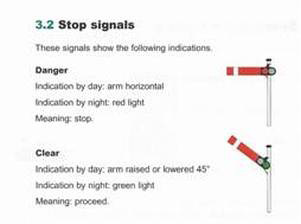
Distant, Shunt and Subsidiary signals; what they look like and what they mean; bracket and gantry signals and how they route trains. You look at signal control, interlocking, how signal boxes work to each other and the purpose of block instruments. You’ll learn the meaning of Station Limits, Block Sections and how trains are signalled along the line in both normal and degraded working conditions. You also learn about Intermediate Block Sections and colour light signals – not to be confused with multiple-aspect signals.
Multiple Aspect Signalling
You need to understand the meaning and application of two, three and four-aspect signals, subsidiary signals and how they are controlled from Power Signal Boxes. Also how trains transition between three- and four-aspect areas and between multiple-aspect and semaphore areas. We discuss track circuits, overlaps, axle-counters and how multiple-aspect signals divide the track into Signal Sections. We learn about how Controlled, Automatic and Semi-Automatic signals work, how they are differ from each other, their purpose and the rules involved with each type. You learn about Route Indicators, Theatre
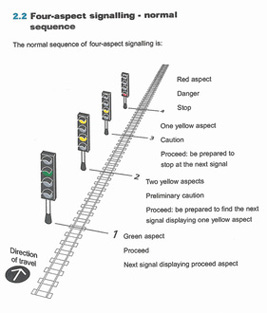
Indicators and flashing yellow aspects approaching diverging junctions. Then there are signals more rarely encountered such as repeater, co-acting, limit-of-shunt, SPAD indicators, and ‘off’ indicators. Again, the working of these systems during normal and degraded working will be discussed at length.
Also considered is how single lines are worked under the various systems. In the future there will be the new European Rail Traffic Management System (ERTMS, also at Wiki) of signalling to learn about.
Another section that concerns Drivers is Section TS8 which deals with Level Crossings – see next section (TW8)
Section TW – Train Working
Section TW1 is a long section which looks at the preparation and movement of trains in general. This covers such matters as booking on and off, the equipment and publications you need to have with you and the reading of and signing for notices. You will learn about route and traction knowledge requirements and about coupling and uncoupling of vehicles. One section covers the classification and speed of trains and another deals with communications and communication equipment. You learn about external train lights, hauling dead vehicles, travelling in driving cabs, carrying out running brake tests, when to sound the horn, what to do when there are people on the line, use of the Driver’s Reminder Appliance (DRA – see film), the stopping of trains en-route, gradients, fog, falling snow, station duties, working of doors, re-starting the train and what to do at the end of the journey. There will be a section on what to do during low adhesion conditions. You also learn about what to do during Permissive Working (i.e. when more than one train can be in the platform), propelling movements and examination of the line.
Section TW2 deals with matters relating specifically to the working of multiple-unit passenger trains: Before entering service, power doors, door defects, brake systems & defects, working in snow, platform equipment, stopping at stations, overrunning stations and coupling & uncoupling.
Section TW3 deals with the working of locomotive hauled trains, which these days is mostly freight trains. It covers light locomotives, train preparation, brakes systems, doors, starting and stopping passenger trains, coupling locomotives and assisting trains.
Section TW5 (there is no TW4) is an important and lengthy section covering defective train equipment. This involves such things as defective speedometers, TPWS, horns, windscreen-wipers, doors, door controls, lights, buzzers, radios, sanders, DRAs, tilt systems, Track Circuit Activators (TCAs) broken windows, brake isolations etc. You also look at what happens when you need to use the Emergency By-Pass Switch (EBS) on multiple-unit trains and at how to deal with hot axle-boxes.
Section TW6 looks at how single lines are signalled under the various systems and will probably be dealt with when you are learning about signalling systems generally.
Section TW7 looks at how Wrong Direction Movements are made. You might make these if you overrun a platform, after taking a wrong route, when the line is obstructed or during an exceptional incident.
Section TW8 is concerned with Level Crossings and should be read in conjunction with Section TS8. Here you learn about how Manned Barriers, Automatic Half Barrier (AHB), Closed Circuit Television (CCTV) crossings and various sub-types work and how you behave towards them. You consider approach speeds, Wrong Direction controls and the hand signalling of crossing during failure situations.
Section SS – Station Working and Shunting
Section SS1 is concerned with station duties and train dispatch: Who is in charge, platform equipment, opening of doors, barrow crossings, safety of passengers, retrieving articles fallen on the track and giving the driver authority to start the train from staffed and unstaffed stations. (click here and here for films)
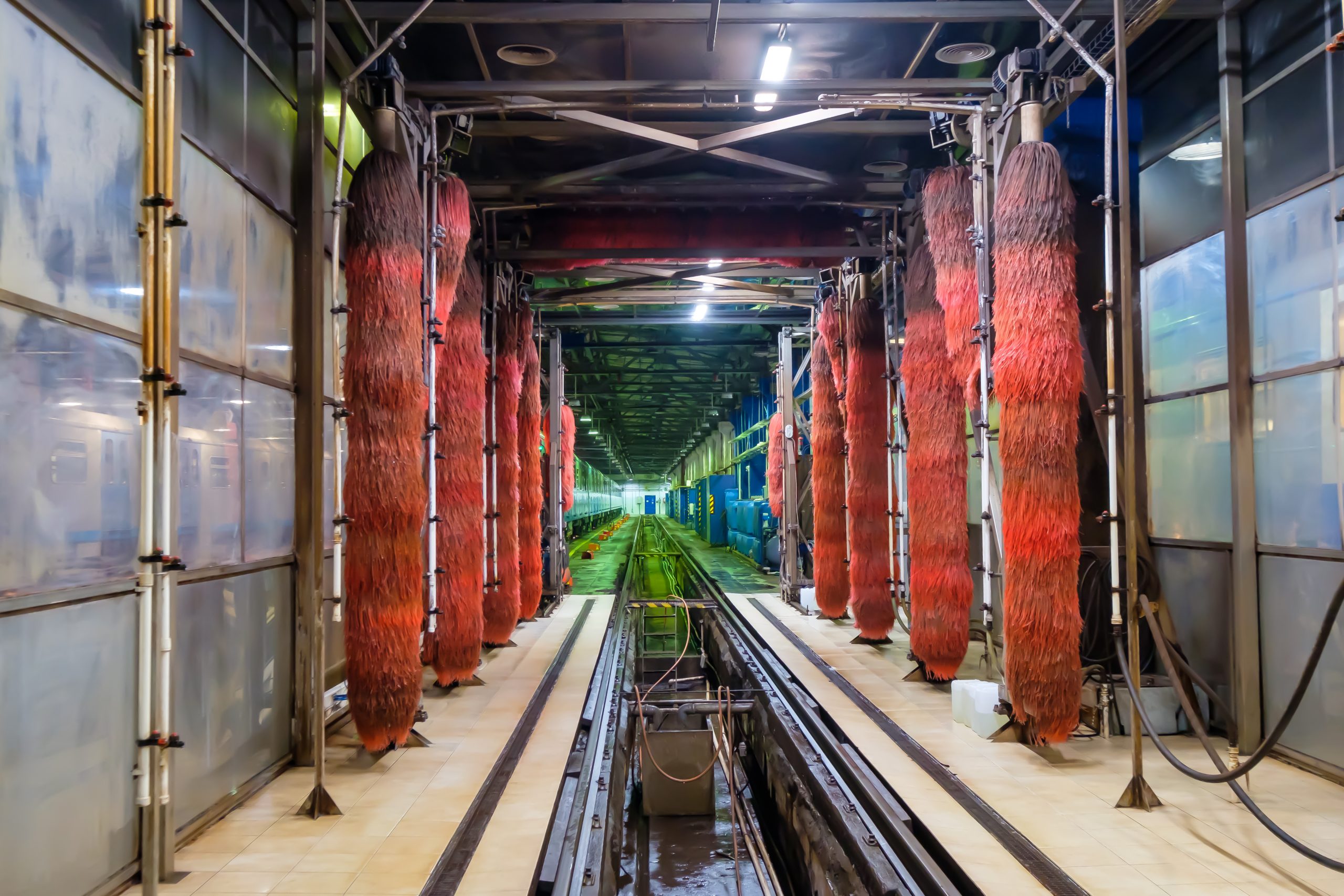
Carriage Wash Plant
Section SS2 deals with shunting in yards and siding: Working of points, yard signals, stop boards, ground frames and the control and making of movements. You will also learn about yard staff, cleaners, fitters and shunters and how to communicate and work with them. Then there is the matter of shunting handsignals both by day and night. Coupling and un-coupling of vehicles and units will be dealt with as will working through wash plants and movements within depot buildings and at fuel-points.
Section SP – Permissible Speeds and Speed Restrictions
This section deals normal linespeed restrictions: how to find out about them in publications and the various ways in which they are indicated at the lineside. Differential speed restrictions will also be looked at.
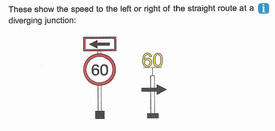
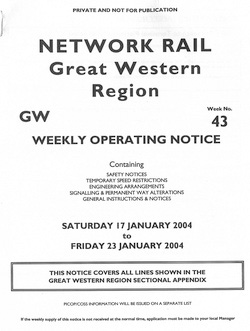
You next learn about how Temporary Speed Restrictions are imposed, notified and withdrawn. You will be taught about weekly and monthly notices and about the function of the Late Notice Case at your depot. Also what the various speed boards look like, how they are laid out and how to react to them. Unusual situations will also be covered such as speed restrictions beyond diverging junctions, restrictions within restrictions and differential restrictions. Failure situations will also be dealt with such as what happens when boards are
missing.
Finally you look at what happens when it is necessary to impose a speed restriction without previous notice. Attention will be paid to how a driver is advised of such restrictions and what special lineside apparatus is involved.
Section M – Mishaps, Incidents and Extreme Weather
Section M1 looks at what happens when trains are stopped by accident, fire or division. You learn about what to do in these dangerous situations, who to contact, how to carry out Emergency Protection with detonators and track circuit clips, deal with fires and carry out both controlled and emergency evacuations of passengers.
Section M2 deals with the more commonplace event of train failures: Contacting the Signaller, carrying out Assistance Protection and the arranging and providing of assisting trains. This section will also deal with how the trains are signalled in these situations and you will learn what to do when you are the driver of the assisting train.
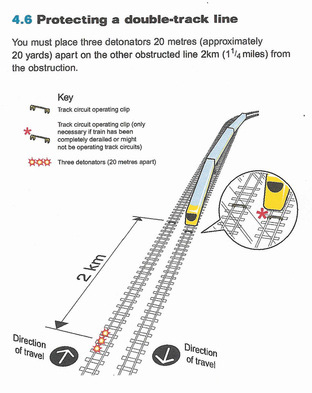
Section M4 (there is no M3) contains additional instructions for movements in floods and snow and deals with snowploughs.
Section M5 deals with the Managing Accidents. As well as your immediate duties as a driver you will also learn about how major incidents are dealt with: The appointment of officers, handling the media, rescue operations and the preservation of evidence. This section will also deal with fatalities on the line (fatalities to trespassers and suicides being something you will almost certainly have to deal with at some point in your career).
Section P – Working by Pilotman
Pilotman Working is introduced to ensure safe working of trains following the failure of equipment or an obstruction of the line. You will learn about how and why the pilotman is appointed, what he does, when he rides with you and when he issues you with a Driver’s Ticket; how signals are worked and how movements are made.
Section P1 deals with how trains work in both directions over one track of a double track railway when the other track is out of use. This type of working used to be very commonplace during Sunday engineering work but is rarer today now that blockades tend to be used. It will deal with how SLW is set up and withdrawn, the appointment and functions of the pilotman, SLW Tickets, control of movements in right and wrong directions, what happens during train failures and where there are more than two running lines.
Section P2 goes on to deal with Pilot Working single and Bi-directional lines during signal and track-circuit failures.
Section T – Track & Signalling Work
Although you will only be directly involved with engineering trains if you join a freight company that does such work you still need to be acquainted with how engineering possessions are conducted. This part of your course will deal with the protection of engineering possessions and worksites, signalling arrangements, Persons-in-Charge (PICOP), Engineering Supervisors, how authority for movements is given and how possessions are withdrawn. The only section that is issued to Drivers is Section T11, which deals with movements into, out of and within possessions. Several other sections not issued to Drivers deal with the operation of the possession itself, the conduct of work, Handsignallers duties and the loading & unloading of engineering trains.
Other matters that will be dealt with during your Rules course will include Lifestyle and Shiftwork Awareness training, SPAD Awareness training and Professional Driving Techniques.
The last two days of this period will be Rules Examination with a Driver Manager.
Traction Theory Training. These four weeks will be mainly in the classroom, though there will probably be a depot visit early on so that you can get a sense of the layout of the various train parts you will talking about. The basic format is that you always do your initial theory training on whatever has been designated as the basic traction for your company or depot. At freight companies this will be the Class 66
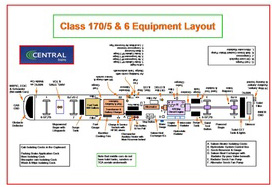
locomotive, while at passenger companies it will be the predominant multiple-unit type. After doing your basic traction you may train on additional types or in some cases this will be left until after you have completed your Driver’s Course, particularly if it involves cross-training between diesels and electrics.
You will learn about the layout of your basic traction in detail: The names of all the parts, where all the circuit breakers, fuses, isolating cocks and emergency equipment are located. Then you will learn about the diesel engine, power control, the fuel, oil, coolant and fire suppression systems. You will learn about the braking system, how the brakes are controlled along the train and about how to deal with failures and isolations. You will also look at secondary systems such as air-conditioning, suspension, passenger information systems and train lighting. If you are learning electrics the diesel part of this course would be replaced with learning about how power is transmitted to the train, transformers, thyristors and power control issues.
Train preparation and disposal duties will be covered in detail as will the identification of faults and failures. You need to know which symptoms relate to which sorts of faults; how to trace faults and correct or overcome them.
There will be a Traction Theory assessment at the end of this module. Click here for a film about faults and failures on the class 455 EMU.
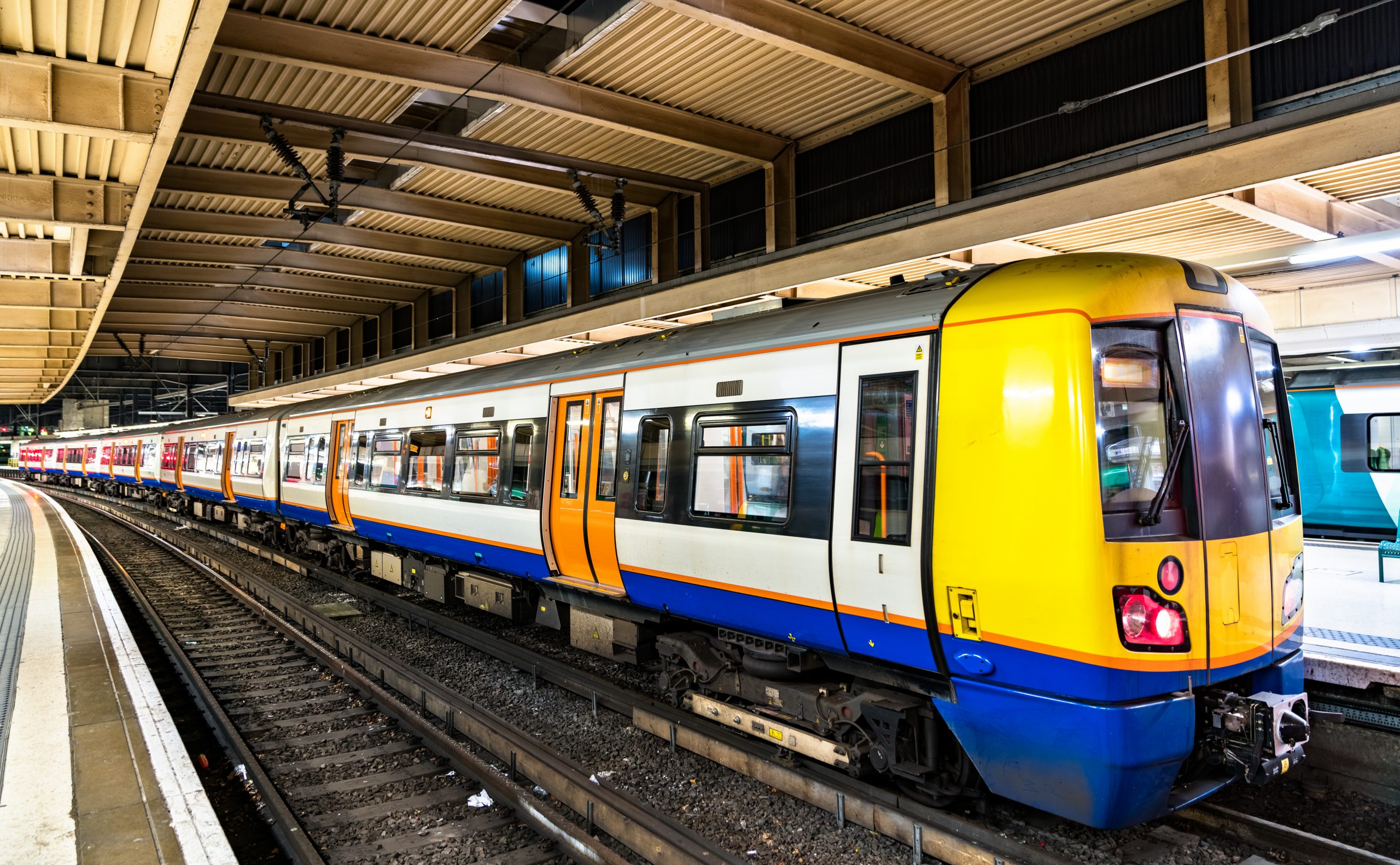
Practical Train Handling on a Depot. This is where you get to drive a train for the very first time – albeit at about 5mph on a depot under the close supervision of your instructor. It just gives you an opportunity to practice getting comfortable in the cab, manipulating the driving controls, moving away safely and gently and stopping the train accurately. You will also gain an insight into shunting movements in a depot environment and how to couple and uncouple trains – click here for a film about this. Again, there is an assessment.
Route Learning Principals. This week is aimed at familiarising you with what it is that constitutes Route Knowledge, how that knowledge is gained and what you need to absorb as you go out route learning. The main part of this week will be your assignment to go out and learn a short section of core route and draw a map of the route which you will present at the end of the week. There is more about Route Learning on the next page.
Practical Handling. At last, this where you finally get to handle real trains, not training trains (that would be too expensive) but trains in actual revenue service. Over these twelve weeks you will undertake two to three hundred hours driving, a third of which will be in darkness. You will be assigned one-to-one to an Instructor Driver who will teach you all about what we now call professional train driving – how to start away, accelerate and brake, stop at stations and carry out station duties; how to recognise signals, learn the route, observe speed restrictions and react to events. The instructor will also teach you about working to schedule, the DRA, TPWS, interpretation of signals, correct use of the horn, stopping out-of-course, using the SPT, running brake tests, the differences in handling between tread and disc braked trains, changing ends and to generally put into practice all you’ve learned in the classroom. You will probably start out on off-peak or empty trains and simple routes before moving on to busier trains and complex areas as your experience builds. Click here for a film about energy-efficient driving and here for a film about driving the class 365/465 Networkers).
You will also visit maintenance depots learning where all the equipment, circuit breakers and isolating cocks are on the trains you will be driving as well as how to prepare, test, dispose, couple & uncouple them and how to deal with simulated failures.
Many companies have invested heavily in driving simulators, some of which have full motion platforms and are very realistic. If you are taken on by such a company some of your initial ‘driving’ will be on these and they are a very good way of dealing with situations not usually encountered.
Click here for a half-hour ‘driver briefing film’ made by London Overground about operating risks.
Driving Simulator Videos by Track Access Services
You will be given extensive instruction on the fraught issues of how to start and stop trains under the low adhesion conditions of the leaf-fall season – assuredly no joke despite the sarcastic rubbish you see annually in the media. Almost certainly some of this will be done on a simulator, although some companies go one better and give skid-pan training on specially oiled sections of line under a possession or on a heritage railway. If you’re not doing your training in the autumn you will also be accompanied by an instructor for a few days during the worst of your first autumn after passing out – you’ll need the guidance! Click here for the films Low Adhesion Driving and Forewarned is Forearmed.
Handling Assessment. This is a full week of practical assessment of your train handling skills and underpinning knowledge which will be conducted by a Driver Manager. If it all goes well then..
That’s it – you’re a certificated Train Driver, authorised to drive trains on Network Rail lines!
Since you were probably not allowed to go on holiday while training you will now take a couple of weeks deferred annual leave before going on to start your route learning.
This comprehensive collection of online Train Driver recruitment resources is the perfect resource for any aspiring Train Driver!
![]()
Please note: your transaction will be handled by our partner website How2become Ltd.
For all enquiries please contact [email protected]

